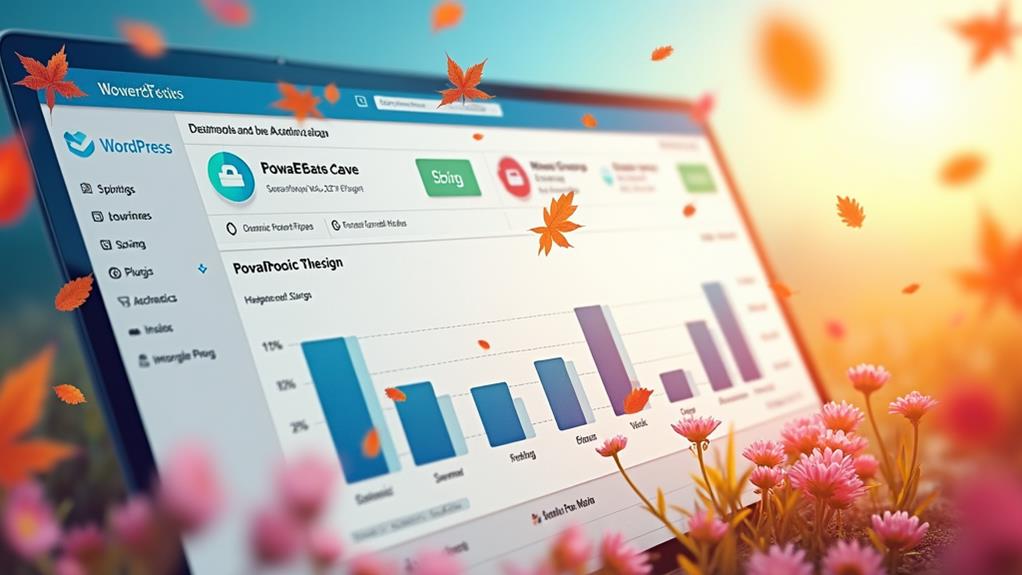Seasonal content is essential for e-commerce businesses, driving significant engagement and sales optimization. Holiday shopping alone can account for 30% of annual sales, while events like Valentine's Day can boost product searches by 45%. Tailoring content with seasonal themes enhances visitor numbers by 55%, and themed campaigns drive 20% increased engagement compared to standard content. Planning campaigns in advance, optimizing SEO, and incorporating weather trends can magnify results. Businesses typically dedicate 15-20% of their marketing budget to capture the seasonal surge, leading to higher conversion rates. For continued success in this competitive landscape, further exploration of these strategies is invaluable.
Key Takeaways
- Seasonal content drives a 20% increase in engagement compared to standard content.
- Aligning with seasonal themes boosts visitors by 55%, enhancing e-commerce visibility.
- Seasonal storytelling fosters long-term engagement, improving customer retention by 30%.
- Tailored promotions during peak seasons can significantly increase sales volume.
- Seasonal SEO optimization attracts 55% more visitors, enhancing search engine visibility.
Understanding Seasonal Trends
Understanding seasonal trends is essential for e-commerce businesses seeking to optimize their sales strategies and maximize revenue. By analyzing consumer behavior patterns, businesses can align their marketing strategies with seasonal demands, ensuring they capitalize on peak shopping periods.
For instance, the holiday shopping season from October to December can account for up to 30% of annual sales for many retailers, highlighting the importance of targeted promotions during this time.
Trend analysis further reveals that back-to-school sales in late summer drive considerable demand, with U.S. parents spending approximately $37 billion annually. Events like Valentine's Day and Halloween also create notable spikes in specific product categories, evidenced by a 45% increase in searches for gifts and party supplies.
Understanding these shifts allows businesses to tailor their inventory and marketing efforts to meet consumer expectations effectively.
Moreover, weather influences seasonal trends greatly, impacting industries such as fashion and outdoor gear. For example, winter apparel sees heightened sales during colder months, while summer products thrive in warmer periods.
Leveraging tools like Google Trends can aid businesses in tracking these patterns, enabling them to develop targeted marketing strategies that align with consumer interests and maximize sales potential.
Benefits of Seasonal Content
Capitalizing on seasonal trends not only involves aligning inventory and marketing strategies but also crafting engaging seasonal content that resonates with consumers. This approach is instrumental in enhancing brand visibility during peak traffic periods.
Studies demonstrate that seasonal campaigns can drive up to 20% more engagement compared to standard content. The benefits of seasonal content are multifaceted:
- Increased Engagement and Sales: Aligning content with consumer behavior during specific times of the year can lead to a significant 55% increase in visitors. This is a result of content alignment with relevant seasonal themes and trends, which effectively captures consumer interest and boosts sales.
- Long-term Consumer Engagement: Seasonal content caters to consumers' evolving interests, fostering long-term engagement. This strategy not only influences purchasing decisions throughout the year but also results in a 30% higher retention rate among customers who connect with the brand's storytelling.
- Efficient content Strategy: Incorporating seasonal elements in marketing efforts aids in efficient content strategy planning. It simplifies topic generation by integrating national and minor holidays into content calendars, thereby optimizing overall marketing strategy and ensuring content remains relevant and impactful.
Strategies for Seasonal Marketing
Effective strategies for seasonal marketing are essential for e-commerce businesses aiming to harness peak consumer engagement and drive sales. Advance planning is vital; developing holiday campaigns at least a quarter in advance enables businesses to optimize based on historical data and consumer behavior trends. This proactive approach guarantees that product selection aligns with seasonal demands, maximizing sales potential.
Seasonal SEO optimization is another important strategy. By incorporating relevant seasonal keywords, businesses can boost product visibility, potentially attracting up to 55% more visitors during peak shopping periods. Such tactics are invaluable for enhancing reach and engagement during high-demand times.
Crafting engaging content is equally important for successful seasonal marketing. Themed blog posts and social media campaigns tailored to specific seasons can raise customer engagement and drive higher conversion rates. This content should highlight strategic product selection to resonate with consumers' seasonal preferences.
Promotions and discounts play a significant role in stimulating purchases. Time-sensitive offers during events like Black Friday or Valentine's Day can greatly enhance sales volume.
Allocating Seasonal Budgets
To maximize the impact of seasonal marketing strategies, e-commerce businesses must prioritize the efficient allocation of their seasonal budgets. Effective budget refinement can lead to increased visibility and higher conversion rates, particularly as businesses often increase their advertising spend by up to 30% during peak shopping seasons. This surge in spending underscores the need for a well-structured approach to seasonal budgeting that leverages data and performance metrics to drive decision-making.
- Real-Time Monitoring: By closely monitoring advertising performance in real-time, businesses can make informed adjustments to their budgets. This responsiveness guarantees that marketing efforts are aligned with consumer responses and dynamic market conditions.
- Strategic Promotions: Allocating resources for promotions and discounts is critical, as 70% of consumers are influenced by price reductions during seasonal sales. By strategically planning these promotions, companies can enhance customer engagement and drive sales.
- Inventory and Resource Management: A successful seasonal budget must also account for inventory management costs. Maintaining adequate stock levels to meet anticipated demand without financial overextension is essential.
For ideal results, companies often allocate 15-20% of their annual marketing budget specifically for seasonal campaigns, considerably boosting sales and engagement during high-demand periods.
Enhancing Post-Season Performance
Analyzing post-season performance is essential for e-commerce businesses aiming to refine their strategies and enhance future outcomes. By examining metrics such as conversion rates and customer engagement, businesses can identify both successful approaches and areas requiring improvement. This data-driven insight guarantees that future seasonal strategies are robust and aligned with customer expectations.
Implementing retargeting campaigns is a strategic move post-season; as 70% of consumers are more inclined to purchase from a brand they have previously engaged with, this approach can effectively maintain brand visibility and drive repeat purchases.
Customer feedback is a goldmine for e-commerce businesses post-season. Gathering insights from customers allows businesses to refine their offerings and improve the shopping experience, ultimately boosting customer satisfaction and fostering loyalty. This feedback, coupled with a thorough cost-benefit analysis of the seasonal campaigns, empowers businesses to make informed decisions regarding budget allocations and resource distribution.
Additionally, repurposing seasonal content for off-peak marketing efforts provides a continuous stream of engagement opportunities, keeping the brand relevant throughout the year. This strategy not only enhances post-season performance but also contributes to sustained profitability and customer engagement beyond the peak seasons.
Frequently Asked Questions
How Do Seasonal Content Strategies Vary Across Different Industries?
Seasonal content strategies vary across industries by aligning with specific holiday marketing and industry trends. Retail focuses on major holidays, while hospitality leverages travel seasons. Trend-aware businesses analyze consumer behavior patterns to tailor strategies for targeted audience engagement.
What Tools Can Help Identify Relevant Seasonal Keywords?
To identify relevant seasonal keywords, tools like Google Trends, SEMrush, and Ahrefs are invaluable. These platforms offer keyword research capabilities and trend analysis, enabling businesses to align content with audience interest fluctuations and market dynamics effectively.
How Can Seasonal Content Impact Brand Loyalty?
Seasonal content enhances brand loyalty by boosting customer engagement and leveraging promotional tactics. Data suggests that targeted, timely content increases audience retention and satisfaction, fostering a stronger emotional connection and commitment to the brand amidst shifting market trends.
What Are the Risks of Not Updating Seasonal Content Annually?
Failing to update seasonal content can lead to content stagnation, causing customer disengagement. Data indicates that consumers expect fresh, relevant material. Trend-aware strategies are critical to maintaining engagement and driving audience-focused growth in dynamic e-commerce environments.
How Can Small Businesses Compete With Larger Brands Using Seasonal Content?
By leveraging holiday promotions and niche targeting, small businesses can effectively compete with larger brands. Data shows personalized campaigns resonate with specific audiences, enabling trend-aware strategies that capitalize on timely market opportunities and enhance competitive positioning.
Conclusion
Incorporating seasonal content into e-commerce strategies is vital for capitalizing on consumer behavior trends, enhancing engagement, and driving sales. An understanding of seasonal trends enables businesses to tailor marketing strategies effectively, resulting in increased conversion rates and customer loyalty. Strategic budget allocation guarantees ideal resource use during peak seasons, while post-season analysis informs future campaigns. Data-driven insights and trend awareness are essential for maintaining competitiveness and improving performance in the ever-evolving e-commerce landscape.




